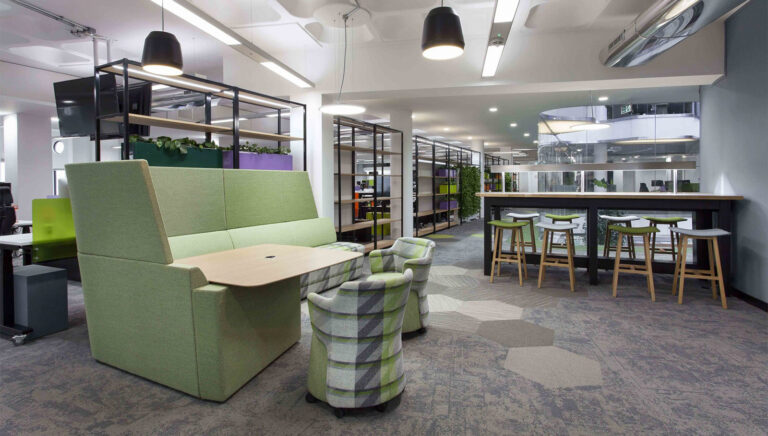
Communication & Engagement in a World of Fragmented Working.
Date
2 November 2020
Read length
3 min
Communication has been business critical throughout the pandemic and has played an important role in making employees feel valued and supported during unprecedented times.
With the transition to agile working and enforced home working happening almost overnight, businesses had a myriad of challenges to content with as as they found ways to make their operations, processes and people remote. Those that communicated well with their customers, employees and peers will have endured the storm of 2020 well – giving them the means to keep people engaged, supported and loyal. Those that let this fall down the priority list, will have endured an even harder time.
This year has taught us much about business and the necessity for effective communication. With that in mind, and using data from our Annual Insight Workplace Trend Report, here are our top 4 take-away communication lessons from 2020:
Recognising different needs.
The most successful communications strategies during lockdown used simple language, a personal approach and humour to land key messages. Shorter and frequent messaging yielded better messaging momentum.
Over-communication was seen as a distraction and a barrier to effective working, while under-communication left employees feeling adrift and isolated.
Millennials, who make up around 40% of the UK workforce, preferred fast and frequent messaging, which aligns with ‘FOMO’ (fear of missing out) attitudes, shorter attention spans and preference of live feeds for news. Gen X and Baby Boomers preferred regular and reassuring updates. Honesty and transparency were most valued, even if it was bad news.
Take-away – Take into account employees’ communications preferences regarding frequency, type and channel. Get it right and engagement will improve.
Filling a void
Regular communication played a vital role in replacing the temporary loss of the physical workplace community. Organisations that initiated participatory activities, such as digital coffee mornings, socials and mental health forums, helped provide assurance and maintain a sense of belonging.
Take-away – Covid-19 has made the needs of remote workers mainstream for the first time. Use this experience to ensure those working remotely (which could be everyone for some part of their working week), feel included and engrained in the organisation’s culture even if it’s virtually. Communication is intrinsic to belonging, wellbeing and productivity,
Concentration concerns
While many employees missed informal social communication with colleagues in the office (it was 14th in our list of obstacles to home working) the benefits of being able to focus without distraction at home (this was third in our benefits to home working) saw 50% of responders to our surveys believe that their productivity had increased during lockdown.
The ability to mark yourself as ‘busy’ in Teams or to screen calls and chats from colleagues enabled many to focus on tasks far better than in the office. The downside being that problem solving and groupwork was harder to perform when not face-to-face (8th in our list of obstacles to home working).
Take away – Workplaces need to make greater provision for activity based work settings so that spaces exist for concentration as well as team work. While lockdown has proven that lots of knowledge-based head-down tasks can be completed at home successfully – concentration in the workplace will always be vital.
Embracing video
Covid-19 has made us all familiar with and willing to use VC technology. Overall, most employees felt they were supported in their work through a blend of broadcast, two-way communications and VC meetings, which were readily adopted.
In our surveys 62% reported they were always able to reach colleagues. However, recent follow up studies show that although VC calls provided efficiency and short-term effectiveness, they didn’t fully replace the human contact, conversation flow, ideation and intimacy we crave.
Take-away: Video looks set to remain an everyday component of our working lives, particularly as more people work remotely and need to work collaboratively – workplaces must accommodate this new way of working.
Summary.
Thanks to Covid-19 we now have a much greater understanding of how to make communities virtual and to create solidarity, belonging and inclusion even when we’re apart. It’s also reiterated just how important human connection and face-to-face contact is for us.
The challenge for employers is to acknowledge that the role of the workplace is changing and that we need blended future flexible workplaces in order to thrive. People have craved human contact throughout the pandemic and will want the workplace to offer the experiences and support the tasks that can’t be achieved at home.
While the pandemic and its subsequent homeworking has created vastly different experiences for people, one constant remained throughout – the need for clear communication and connectedness.
To find out more about the findings from our annual insight survey of more than 43,000 UK employees and the changes affecting the workplace, download a copy of our Annual Insight Workplace Trend Report here…
See how we could help with your new office interior design or office design and build project here
Get in touch
We love nothing better than talking all things workplace and design – got a question, potential project or just need some guidance?
Drop us a note…





